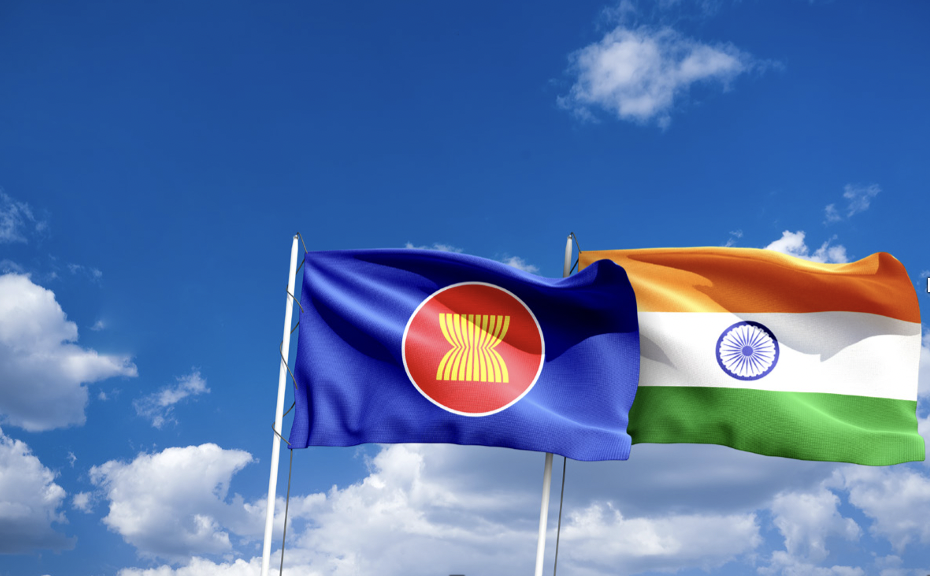
India Moves in on Southeast Asia
China’s decline has given New Delhi an opportunity.
Victoria Herczegh
Last week, the foreign ministers of India and the Association of Southeast Asian Nations met in Vientiane to discuss ways to enhance political, security and economic relations and to address regional issues, including China’s assertiveness and the crisis in Myanmar. In his address, India’s top diplomat said ASEAN was the cornerstone of India’s vision for an open, stable and prosperous Indo-Pacific region. It was, to some extent, in keeping with precedent. India-ASEAN relations have been on sound footing since 1995. But things started to change during China’s economic explosion in the early 2010s. Its unprecedented growth was attractive to ASEAN’s ambitious developing members (Indonesia and Thailand), while poorer countries (Cambodia and Myanmar) saw trade with the rising superpower as a remedy to their economic and financial problems. Though it was easier to do business with China than with India, where efficient economic reforms were introduced much later, Beijing also began working against India by entering into small regional networks and partnerships, integrating itself into as many economic schemes as it could. China outmatched India to become the top trade and security partner for ASEAN – a position that seemed secure and fruitful for both sides.
It was, to some extent, in keeping with precedent. India-ASEAN relations have been on sound footing since 1995. But things started to change during China’s economic explosion in the early 2010s. Its unprecedented growth was attractive to ASEAN’s ambitious developing members (Indonesia and Thailand), while poorer countries (Cambodia and Myanmar) saw trade with the rising superpower as a remedy to their economic and financial problems. Though it was easier to do business with China than with India, where efficient economic reforms were introduced much later, Beijing also began working against India by entering into small regional networks and partnerships, integrating itself into as many economic schemes as it could. China outmatched India to become the top trade and security partner for ASEAN – a position that seemed secure and fruitful for both sides. Then came India’s own rapid economic ascent. Though its rise was slower than China’s, India is now seen the world over as a viable competitor to China, one capable of defeating the East Asian giant and leading economic growth by the end of the decade. Indeed, China is not as reliable as it once was, its economic decline marked by unkept promises on investment and dozens of unfinished or stalled infrastructure projects all over Southeast Asia. Beijing’s assertive military presence and disputed territorial claims in the South China Sea have also strained ties with the bloc. India has thus seized the opportunity to improve its standing with ASEAN, openly advocating “ASEAN centrality” as the best way to promote stability and growth in the region.
Then came India’s own rapid economic ascent. Though its rise was slower than China’s, India is now seen the world over as a viable competitor to China, one capable of defeating the East Asian giant and leading economic growth by the end of the decade. Indeed, China is not as reliable as it once was, its economic decline marked by unkept promises on investment and dozens of unfinished or stalled infrastructure projects all over Southeast Asia. Beijing’s assertive military presence and disputed territorial claims in the South China Sea have also strained ties with the bloc. India has thus seized the opportunity to improve its standing with ASEAN, openly advocating “ASEAN centrality” as the best way to promote stability and growth in the region.At first, India’s overtures made ASEAN member states somewhat wary. After all, China’s increased involvement in its affairs, however beneficial at first, ended up making the bloc vulnerable in security and economic terms. The revival of the Quadrilateral Security Dialogue consisting of the United States, India, Japan and Australia, as well as the formation of AUKUS (a security partnership between Australia, the U.K. and the U.S.), has only increased ASEAN’s apprehension over being left behind amid new and changing great power competition. But it has since become clear that India, the U.S., Japan and Australia support ASEAN centrality in their respective Indo-Pacific strategies, and the bloc realizes that it may keep its regional influence and reap the benefits of the competition.
T oday, ASEAN is one of India’s most important trading partners. Bilateral trade under the ASEAN-India Trade in Goods Agreement reached $122.67 billion last year. The agreement, signed in 2009 after six years of negotiations, was meant to facilitate the free flow of goods and deeper economic integration. Most of India’s trade under the deal is directed at manufacturing powerhouses like Thailand, Singapore and Malaysia.
oday, ASEAN is one of India’s most important trading partners. Bilateral trade under the ASEAN-India Trade in Goods Agreement reached $122.67 billion last year. The agreement, signed in 2009 after six years of negotiations, was meant to facilitate the free flow of goods and deeper economic integration. Most of India’s trade under the deal is directed at manufacturing powerhouses like Thailand, Singapore and Malaysia.
Moreover, India’s position on freedom of navigation and its allegiance to international law, including the United Nations Convention on the Law of the Sea, aligns with ASEAN’s regional interests. In April, India delivered BrahMos missiles to the Philippines – the first batch of a $375 million deal with Manila. The agreement is India’s most valuable defense export deal to date, helping New Delhi see the region as a viable export market ripe for similar arrangements.
In turn, it demonstrates to ASEAN that India has what it takes to support its regional defense needs. Expanding defense cooperation agreements and offering technical assistance and training to ASEAN countries could help enhance the defense capabilities of these nations, thereby boosting security within the region and adding to India’s reputation as a reliable and influential military partner. (In May 2023, India held its first joint military exercises with ASEAN in which the Philippines, Brunei, Malaysia, Indonesia, Singapore, Thailand and Vietnam provided ships.)
There are potential obstacles to greater cooperation and prosperity, of course. As an institution, ASEAN makes decisions based on consensus, which is sometimes elusive, other times impossible, especially with regard to the South China Sea. This may well encourage New Delhi to approach individual ASEAN member countries to promote cooperation on a case-by-case basis. On defense and security issues, members such as Cambodia and Malaysia will likely continue to favor China anyway. But in trade and investment, India may take a broader approach. Despite China’s downturn, it still wields substantial influence over ASEAN, and so far, India has reached out largely to the bloc’s more affluent members. Ignoring the others may only make its ambitious goals more difficult to achieve.
Saturday, August 3, 2024
China’s decline has given New Delhi an opportunity
Subscribe to:
Post Comments (Atom)




No comments:
Post a Comment
Note: Only a member of this blog may post a comment.